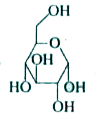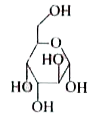Which of the following monosaccharides are present as five membered cyclic structure (furanose structure)?
(a)Ribose
(b)Glucose
(c)Fructose
(d)Galactose
Ribose
Glucose
Fructose
Galactose
The correct Answer is:A, C
To determine which of the given monosaccharides are present in a five-membered cyclic structure (furanose structure), we will analyze each option step by step.
Step 1: Analyze Ribose
- Ribose is a pentose sugar, meaning it has five carbon atoms.
- In its cyclic form, ribose can form a five-membered ring by reacting with its own aldehyde group.
- The structure of ribose in its furanose form consists of four carbon atoms and one oxygen atom in the ring.
- Therefore, ribose does indeed exist in a furanose structure.
Step 2: Analyze Glucose
- Glucose is an aldohexose, meaning it has six carbon atoms.
- In its cyclic form, glucose forms a six-membered ring (pyranose structure) by reacting with its aldehyde group.
- The structure of glucose in the cyclic form consists of five carbon atoms and one oxygen atom, making it a six-membered ring.
- Thus, glucose does not exist in a furanose structure.
Step 3: Analyze Fructose
- Fructose is a ketohexose, which means it has six carbon atoms but contains a ketone group.
- In its cyclic form, fructose can form a five-membered ring (furanose structure) by reacting with its ketone group.
- The structure of fructose in its furanose form consists of four carbon atoms and one oxygen atom in the ring.
- Therefore, fructose does exist in a furanose structure.
Step 4: Analyze Galactose
- Galactose is an aldohexose, similar to glucose, meaning it has six carbon atoms.
- In its cyclic form, galactose also forms a six-membered ring (pyranose structure) by reacting with its aldehyde group.
- The structure of galactose in the cyclic form consists of five carbon atoms and one oxygen atom, making it a six-membered ring.
- Thus, galactose does not exist in a furanose structure.
Conclusion
Based on the analysis:
- Ribose (a) and Fructose (c) are the monosaccharides that exist in a five-membered cyclic structure (furanose structure).
- Therefore, the correct answer is (a) Ribose and (c) Fructose.
Summary of Answers:
- (a) Ribose - Yes, furanose structure
- (b) Glucose - No, pyranose structure
- (c) Fructose - Yes, furanose structure
- (d) Galactose - No, pyranose structure
Final Answer:
The monosaccharides that are present as five-membered cyclic structures (furanose structures) are:
- (a) Ribose
- (c) Fructose
- Ribose is a pentose sugar, meaning it has five carbon atoms.
- In its cyclic form, ribose can form a five-membered ring by reacting with its own aldehyde group.
- The structure of ribose in its furanose form consists of four carbon atoms and one oxygen atom in the ring.
- Therefore, ribose does indeed exist in a furanose structure.
- Glucose is an aldohexose, meaning it has six carbon atoms.
- In its cyclic form, glucose forms a six-membered ring (pyranose structure) by reacting with its aldehyde group.
- The structure of glucose in the cyclic form consists of five carbon atoms and one oxygen atom, making it a six-membered ring.
- Thus, glucose does not exist in a furanose structure.
- Fructose is a ketohexose, which means it has six carbon atoms but contains a ketone group.
- In its cyclic form, fructose can form a five-membered ring (furanose structure) by reacting with its ketone group.
- The structure of fructose in its furanose form consists of four carbon atoms and one oxygen atom in the ring.
- Therefore, fructose does exist in a furanose structure.
- Galactose is an aldohexose, similar to glucose, meaning it has six carbon atoms.
- In its cyclic form, galactose also forms a six-membered ring (pyranose structure) by reacting with its aldehyde group.
- The structure of galactose in the cyclic form consists of five carbon atoms and one oxygen atom, making it a six-membered ring.
- Thus, galactose does not exist in a furanose structure.
Based on the analysis:
- Ribose (a) and Fructose (c) are the monosaccharides that exist in a five-membered cyclic structure (furanose structure).
- Therefore, the correct answer is (a) Ribose and (c) Fructose.
- (a) Ribose - Yes, furanose structure
- (b) Glucose - No, pyranose structure
- (c) Fructose - Yes, furanose structure
- (d) Galactose - No, pyranose structure
The monosaccharides that are present as five-membered cyclic structures (furanose structures) are:
- (a) Ribose
- (c) Fructose
Topper's Solved these Questions
- BOOK - NCERT EXEMPLAR ENGLISHCHAPTER - BIOMOLECULES EXERCISE - Short Answer Type Questions29videos
BIOMOLECULES
- BOOK - NCERT EXEMPLAR ENGLISHCHAPTER - BIOMOLECULES EXERCISE - Matching The Columns2videos
BIOMOLECULES
- BOOK - NCERT EXEMPLAR ENGLISHCHAPTER - AMINESEXERCISE - LONG ANSWER3videos
AMINES
- BOOK - NCERT EXEMPLAR ENGLISHCHAPTER - CHEMICAL KINETICSEXERCISE - LONG ANSWER TYPE QUESTIONS5videos
CHEMICAL KINETICS
Similar Questions
Knowledge Check
- Question 1 - Select One
Which of the following structures represents α-D-glucopyranose?
A B
B C
C D
D
- Question 2 - Select One
Which of the following reactions of glucose can be explained only by its cyclic structure?
AGlucose forms pentaacetateBGlucose reacts with hydroxylamine to form an oxime.CPentaacetate of glucose does not react with hydroxylamineDGlucose is oxidised by nitric acid to gluconic acid. - Question 3 - Select One
Which of the following is C-2 epimer of D-Glucose?
AD-GalactoseBL-GlucoseCD-MannoseDD-Fructose
Which of the following structure is present only in prokaryotic cell?
View SolutionWhich one of the following structure is present in all adult vertebrates?
View SolutionWhich of the following anions is present in the chain structure of silicates?
View SolutionIn which of the following structures C-3 is not a chiral center ?
View Solution
Which one of the following is correct structure of 'B'?View Solution

